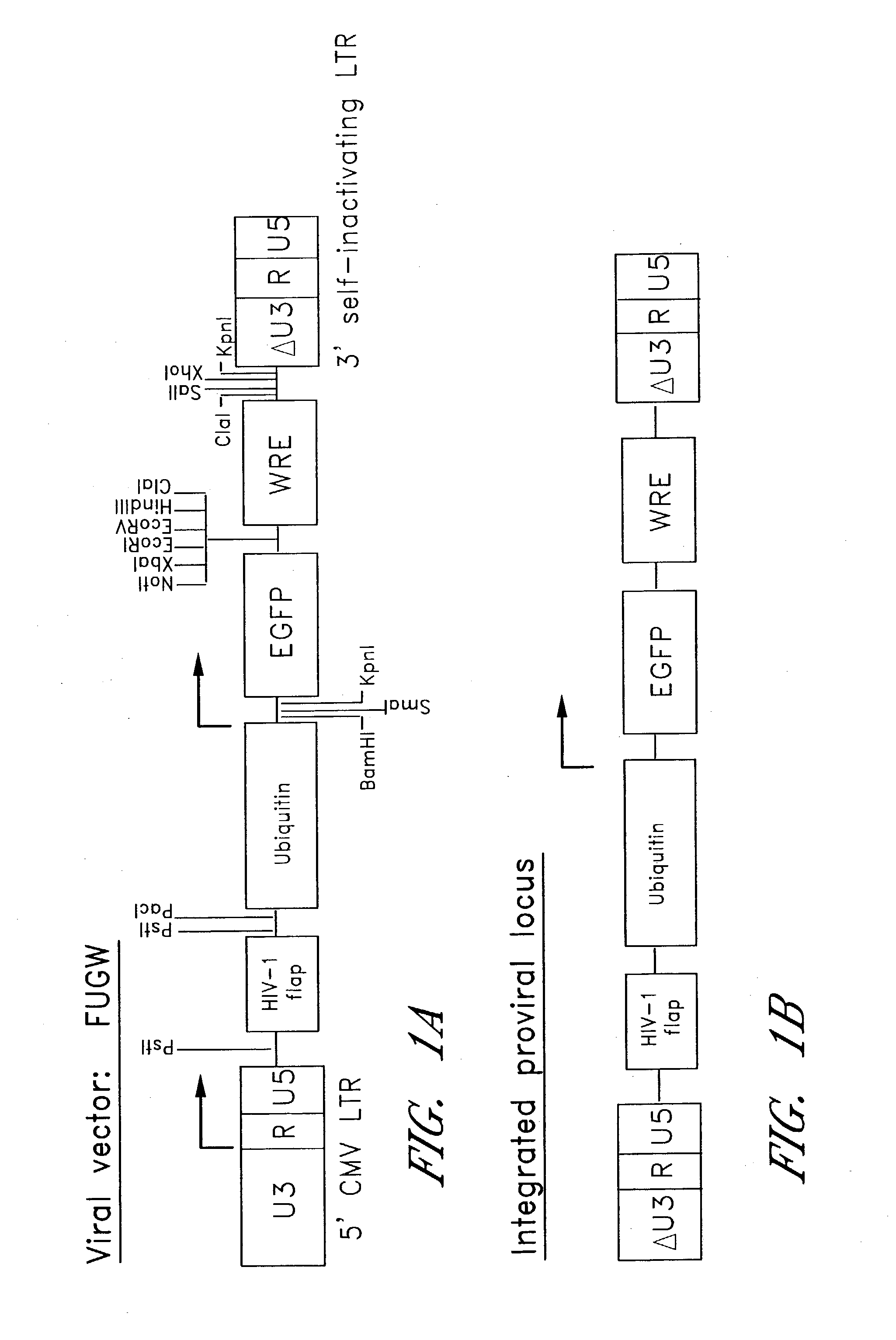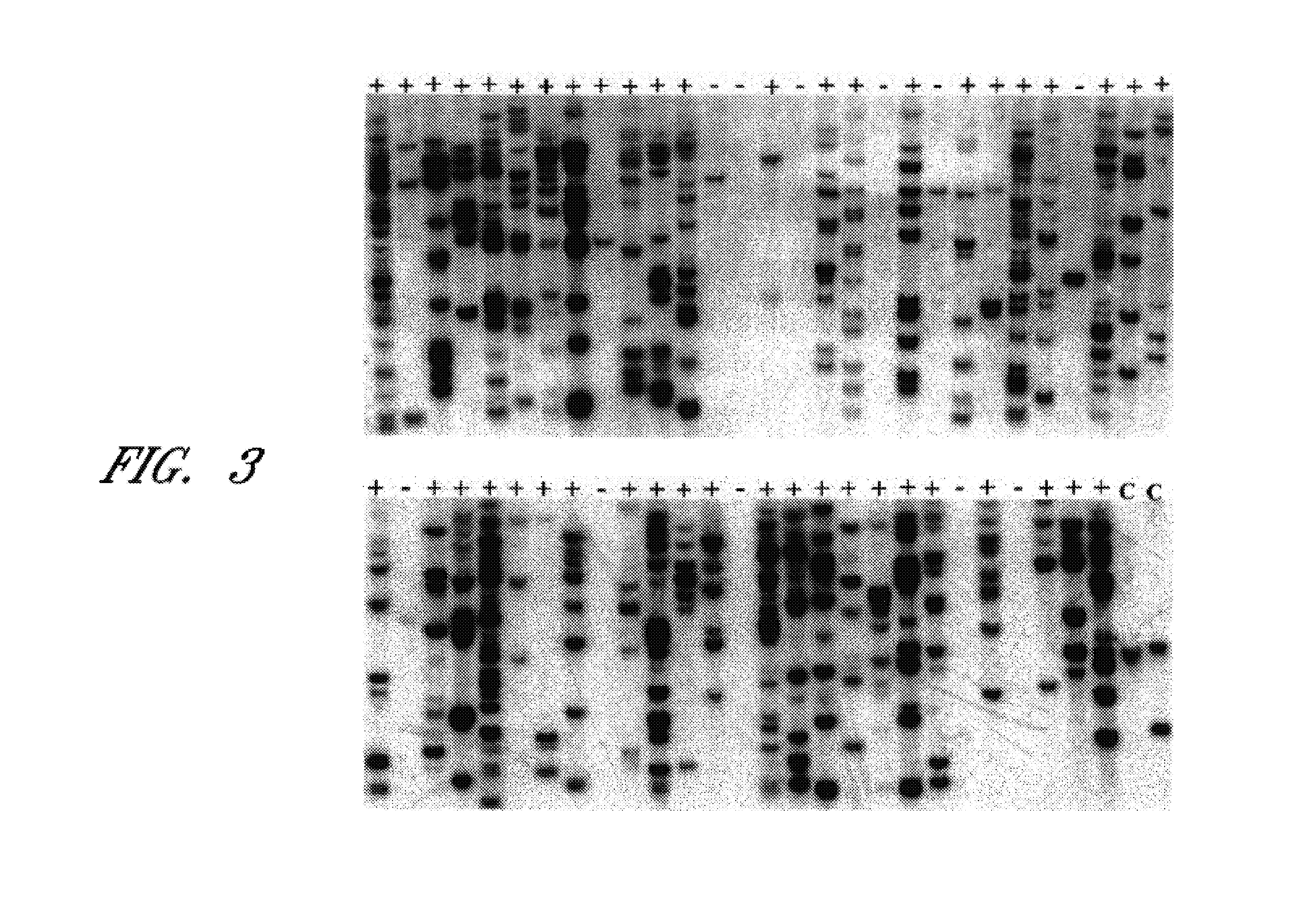Method for producing transgenic birds and fish
a technology applied in the field of transgenic birds and fish, can solve the problems of low percentage of injected zygotes that produce transgenic animals, difficult technique, and low percentage of injected zygotes to achieve the effect of transgenic animals
- Summary
- Abstract
- Description
- Claims
- Application Information
AI Technical Summary
Benefits of technology
Problems solved by technology
Method used
Image
Examples
example 1
[0129]Transgenic mice were generated that expressed a heterologous protein, green fluorescent protein (GFP). GFP expression was controlled by manipulating the genetic elements in the viral construct employed to create the transgenic mice. For example, a viral construct, FUGW, comprising a ubiquitous promoter was used to produce transgenic mice that expressed GFP in every cell. Inclusion of a nuclear localization signal produced transgenic mice that had GFP localized in the nucleus of their cells. A viral construct with a lymphocyte specific promoter produced mice that expressed GFP in lymphocytes, while a viral construct with a muscle specific promoter produced mice that specifically expressed GFP in muscle cells.
A. Viral Constructs
[0130]A viral construct according to the present invention was created using the HR'CS-G plasmid (Miyoshi H, Blomer U, Takahashi M, Gage F H, Verma I M. J Virol. 72(10):8150-7 (1998)). This plasmid is based on the HIV-1 HXB2 proviral DNA (see U.S. Pat. No...
example 2
[0175]Transgenic birds, such as chicken or quail, may be made by the methods of the present invention.
[0176]Freshly laid chicken eggs (day 0) are placed in a temperature-controlled, humidified incubator at 38° C. The embryonic blastodisc is gradually rotated to lie on top of the yolk by gently rocking the eggs in the incubator every 15 minutes. A window is opened in the shell and the blastodisc is visualized in freshly laid eggs (0 hours post-laying) or stage X embryos (36 hours post-laying). VSV-pseudotyped lentiviral particles in solution are loaded into a glass capillary micropipette. To maximize the chances of targeting primordial germ cells, virus is injected in the anterior regions of the O hour embryos and in the gonadal anlage of the 36 hours embryos. Approximately 200 nL of viral solution are delivered into the space between the perivitelline membrane and the embryonic disk with the aid of a hydraulic injector. The shell window is then closed with a porous tape to allow gas...
example 3
[0177]Transgenic zebra finch were made by the methods of the present invention.
[0178]Freshly laid zebra finch eggs (day 0) were placed in a temperature-controlled, humidified incubator at 38° C. The embryonic blastodisc was gradually rotated to lie on top of the yolk by gently rocking the eggs in the incubator every 15 minutes. A window was opened in the shell and the blastodisc was visualized. VSV-pseudotyped lentiviral particles in solution were loaded into a glass capillary micropipette. The lentivirus was derived from the FUH2BGW viral construct described above. To maximize the chances of targeting primordial germ cells, virus was injected in the anterior regions of 0 hour embryos and in the gonadal anlage of 36 hour embryos. Approximately 200 nL of viral solution are delivered into the space between the perivitelline membrane and the embryonic disk with the aid of a hydraulic injector.
[0179]The shell window was closed with a porous tape to allow gas exchange between the embryo ...
PUM
| Property | Measurement | Unit |
|---|---|---|
| pH | aaaaa | aaaaa |
| time | aaaaa | aaaaa |
| temperature | aaaaa | aaaaa |
Abstract
Description
Claims
Application Information
 Login to View More
Login to View More - R&D
- Intellectual Property
- Life Sciences
- Materials
- Tech Scout
- Unparalleled Data Quality
- Higher Quality Content
- 60% Fewer Hallucinations
Browse by: Latest US Patents, China's latest patents, Technical Efficacy Thesaurus, Application Domain, Technology Topic, Popular Technical Reports.
© 2025 PatSnap. All rights reserved.Legal|Privacy policy|Modern Slavery Act Transparency Statement|Sitemap|About US| Contact US: help@patsnap.com



